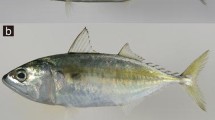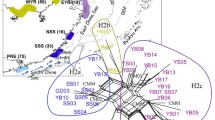Abstract
Frequencies of electromorphs encoded by 14 polymorphic loci were used to estimate genetic distances among samples of the rabbitfishes Siganus argenteus, S. doliatus, S. fuscescens, S. guttatus, S. javus, S. punctatus, S. randalli, S. spinus, S. vermiculatus, and S. (Lo) vulpinus. Samples of the surgeonfish Naso lituratus (Acanthuridae) were included in the electrophoretic survey for the purpose of outgroup comparison. A matrix of genetic-distance estimates was used for construction of dendrograms by neighbor-joining, complete-linkage and single-linkage procedures, and the unweighted pair-group method of arithmetic averages (UPGMA). Cluster analysis revealed interspecific relationships that are concordant with several predictions intimated in the most recent taxonomic revision of this assemblage of fishes. S. randalli and S. vermiculatus, the pair postulated to be sibling species on the basis of strikingly similar external morphology, were found to exhibit the lowest levels of genetic divergence relative to all other pairs of study species. S. randalli, S. guttatus, and S. vermiculatus comprised one of three clusters discerned in all resultant topologies (i.e., “ball clusters”). S. argenteus, S. fuscescens, and S. spinus, three fusiform-bodied species, formed a second ball cluster that was clearly separable from the remainder of the siganids studied (which are all relatively deep-bodied). A third ball cluster contained S. punctatus and S. vulpinus: S. doliatus was depicted as being allied with S. punctatus and S. vulpinus in the neighbor-joining and complete-linkage topologies but not in topologies generated by UPGMA and single linkage. It is noteworthy that S. punctatus, S. vulpinus, and S. doliatus are the only three species included in the present study which purportedly school when young but form pair-bonds as adults. In all topologies, S. javus occupied branches stemming from furcation points between fusiform-bodied and deep-bodied species. Of all the siganids studied, S. argenteus was found to be least divergent genetically from N. lituratus. S. argenteus is the only siganid known to spawn pelagic eggs and undergo a specialized pelagic stage (features typical within the Acanthuridae). Hence, genetic relationships within the Siganidae and among the Siganidae and a representative acanthurid coincide with a host of predictions stemming from morphologic and life-history studies of the Acanthuroidei.
Similar content being viewed by others
Literature cited
Abbott, L. A., Bisby, F. A., Rogers, D. J. (1985). Taxonomic analysis in biology: computers, models, and databases. Columbia University Press, New York
Allen, G. R., Emery, A. R. (1985). A review of the pomacentrid fishes of the genus Stegastes from the Indo-Pacific, with descriptions of two new species. Indo-Pacif. Fishes 3:1–31 (Bernice P. Bishop Museum, Honolulu, Hawaii)
Bell, L. J., Moyer, J. T., Numachi, K. (1982). Morphological and genetic variation in Japanese populations of the anemonefish Amphiprion clarkii. Mar. Biol. 72: 99–108
Hart, G. (1983). The occurrence of multiple UPGMA phenograms. In: Felsenstein, J. (ed.) Numerical taxonomy. Springer-Verlag, New York
Hillis, D. M. (1985). Evolutionary genetics of the Andean lizard genus Pholidobolus (Sauria: Gymnopthalmidae): phylogeny, biogeography, and a comparison of tree construction techniques. Syst. Zool. 34: 109–126
Hillis, D. M., Bull, J. J., White, M. E., Badgett, M. R., Molineux, I. J. (1992). Experimental phylogenetics: generation of a known phylogeny. Science, N.Y. 255: 589–592
Lacson, J. M., Bassler, C. P. (1992). Biochemical systematics of fishes of the genus Stegastes (Pomacentridae) from the Southern Marianas. Mar. Biol. 113: 457–462
Lauder, G. V., Liem, K. (1983). The evolution and interrelationships of the actinopterygian fishes. Bull. Mus. comp. Zool. Harv. 150: 95–197
Leis, J. M., Richards, W. J. (1984). Acanthuroidei: development and relationships. Spec. Publ. Am. Soc. Ichthyol. Herpetol. 1: 547–551
Morizot, D. C., Schmidt, M. E. (1990). Starch gel electrophoresis and histochemical visualization of proteins. In: D. H. Whitmore, (ed.) Electrophoretic and isoelectric focusing techniques in fisheries management. CRC Press, Boca Raton, Florida
Randall, J. E., Heemstra, P. C. (1991). Revision of Indo-Pacific groupers (Perciformes: Serranidae: Epinephelinae), with descriptions of five new species. Indo-Pacif. Fishes 20: 1–332 (B. P. Bioshop Museum, Honolulu, Hawaii)
Rogers, J. S. (1972). Measures of genetic similarity and genetic distance. Studies in genetics. VII. Univ. Tex. Publ. 7213: 145–153
Rohlf, F. J. (1982). Consensus indices for comparing classifications. Mathl Biosci. 59: 131–144
Rohlf, F. J. (1990). NTSYS-pc Version 1.60. Numerical taxonomy and multivariate analysis system. Version 1.60. Exeter Software, Setauket, N.Y.
Rohlf, F. J., Sokal, R. R. (1981). Comparing numerical taxonomic studies. Syst. Zool. 30: 459–490
Romesburg, H. C. (1984). Cluster analysis for researchers. Lifetime Learning Publications, Belmont, California
Saitou, N., Nei, M. (1987). The neighbor-joining method: a new method for reconstructing phylogenetic trees. Molec. Biol. Evolut. 4: 406–425
Sneath, P. H. A., Sokal, R. R. (1973). Numerical taxonomy — the principles and practice of numerical classification. W. H. Freeman & Co., San Francisco
Swofford, D. L., Olsen G. J. (1990). Phlyogeny reconstruction. In: Hillis, D. M., Moritz, C. (eds.) Molecular systematics. Sinauer Associates, Sunderland, Massachusettes
Swofford, D. L., Selander, R. B. (1981). BIOSYS-1: a FORTRAN program for the comprehensive analysis of electrophoretic data in population genetics and systematics. J. Hered. 72: 281–283
Wright, S. (1978). Evolution and the genetics of populations: variability within and among natural populations. University of Chicago Press, Chicago
Woodland, D. J. (1990). Revision of the fish family Siganidae with descriptions of two new species and comments on distribution and biology. Indo-Pacif. Fishes 19: 1–136 (B. P. Bishop Museum, Honolulu, Hawaii)
Author information
Authors and Affiliations
Additional information
Communicated by M. G. Hadfield, Honolulu
Rights and permissions
About this article
Cite this article
Lacson, J.M., Nelson, S.G. Genetic distances among fishes of the genus Siganus (Siganidae) from the Western Pacific Ocean. Marine Biology 116, 187–192 (1993). https://doi.org/10.1007/BF00350008
Received:
Accepted:
Issue Date:
DOI: https://doi.org/10.1007/BF00350008




